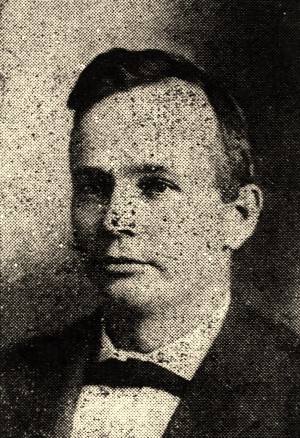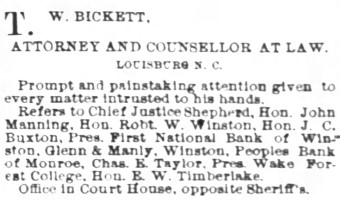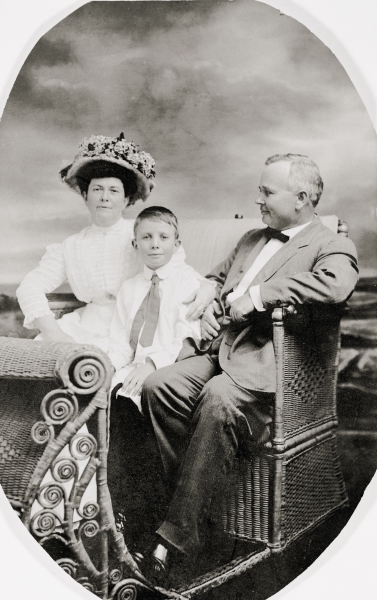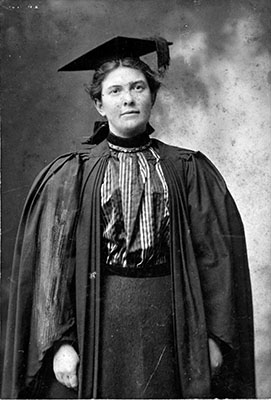Thomas Walter Bickett was born in the small town of Monroe, North Carolina on February 28, 1869. His father, Thomas Winchester Bickett (1836–1882), was a physician and druggist who served the Confederacy as an assistant surgeon. Following the war, Dr. Bickett married Mary Ann Covington (1845–1900), and the couple settled in Monroe, where they had five children: Annie L. Ashcraft, Thomas Walter Bickett, Susie E. Bickett, Lillian E. Brewer, and Lawrence Covington Bickett.
Around 1877, Dr. Bickett’s health began to fail, and though the exact nature of his illness is unknown, it was severe enough that he gave up his physicians practice and shifted his full focus to his pharmacy business.1 Life continued this way for the Bicketts until July 1882, when at the age of forty-two, Dr. Bickett died from “paralysis.”2 The younger Thomas—who, as a boy, answered to the name of Walter—was just thirteen. How Dr. Bickett’s early death impacted the future governor remains unknown. Any surviving writings or correspondence that might betray his personal feelings on this chapter in his life have, so far, remained elusive.
Despite the loss of its patriarch and primary provider, the Bickett family seems to have comfortably supported itself via income derived from the ownership of property in Monroe.3 As a teenager, Walter earned extra money by working summers in cotton fields for twenty-five cents a day.4 In his free time, young Bickett preferred shooting marbles or swimming, “careing (sic) nothing for baseball or the rough sports of that day.”5 He attended and graduated from Monroe High School, where schoolmates were delighted by his clogging skills.6 A song and dance act he performed with his older sister Annie Bickett Ashcraft at a Monroe High commencement ceremony “brought down the house” and was remembered by classmates for decades.7
At seventeen, Bickett entered Wake Forest College, taking out notes (loans) to cover tuition. As a member of the Euzelian Literary Society, he gained a reputation as a strong and capable orator and could often be found with a stack of books the night before a debate. E. H. Austin, a college classmate and lifelong friend, characterized Bickett during this time as “studious, reserved and very ambitious.” “‘I am going to make something out of my life,’ he told me on one occasion,” recalled Austin, “and knowing of his ambition and determination…I have never been surprised at the progress he made in mounting the ladder of success.”8
Above: The earliest known portrait of Thomas W. Bickett, published in 1908. From The Franklin Times, 3 July 1908. Below: An 1895 advertisement for Bickett's new law office in Louisburg. From The Franklin Times, 11 January 1895.
Governor Thomas W. Bickett, Fannie Neal Yarborough Bickett, and William Y. Bickett, circa 1903. Courtesy State Archives of North Carolina.
Bickett's aunt, Elizabeth Andrews Covington, characterized him as “sunshine and good cheer personified.”9 Others remembered Bickett’s unparalleled devotion to his friends. Enoch W. Sikes, another Wake Forest classmate, described Bickett as “an appreciative friend who demanded nothing of me, who never embarrassed me, and in whose presence I felt free to express myself without the slightest hesitation.”10 Upon learning of Bickett’s death in December 1921, G. L. Jones mourned the loss of a dear friendship: “I feel that I have lost more than a friend—almost a brother, or even a father.”11
Graduating from Wake Forest in 1890, Bickett embarked on a brief career as a school teacher to repay his college debts before enrolling in the University of North Carolina to study law.12 Bickett passed the law exam in February 1893 and by 1895 had moved to Louisburg to open a law practice. By the following December, he had so well established himself there that he won election to serve as attorney for Franklin County.13
As Bickett developed his burgeoning law career, he likely caught the eye of a professionally driven, well educated, and ambitious local woman: Fannie Neal Yarborough. In August 1894, at age 24, Yarborough had completed her college studies and returned home to Louisburg to open a private school for girls with her cousin Edith Graham Yarborough.14 It is presumed Fannie had settled down a bit then, with the exception of small social trips and distant summer courses, and met Bickett while teaching in town, but the exact nature of the couple’s early courtship is currently unknown. Either way, by November of 1898, the two had determined to marry and did so on the 29th of that month.15
The Bickett’s marriage, from all available evidence, seems to have been a strong one. In his only surviving will—dated July 4, 1902, just over two years into married life—Bickett left for his children
the infinite riches of their mother’s love, for though they are young now and may not know it I want to tell them in this my last will and testament that their mother is the very noblest and sweetest woman in this world, and if they will walk in her ways they will be happy. I want this clause of my will read to my children once a year.
For Fannie herself, he left all his real and personal wealth and “my blessing for what she has done for me.”16
Their bond was undoubtedly tested when the couple suffered two devastating losses rather early in their marriage. Though their first born, a son named William Yarborough Bickett, lived to adulthood, their youngest two children did not. Thomas Walter Bickett, Jr. died at only eight months old in June 1902. Mary Covington Bickett, having reached fifteen months, died in September 1904. The immense grief caused by their premature deaths remained with Fannie for the rest of her life. In an interview decades later, William’s wife Sarah Cecile Meetze Bickett, recalled her mother-in-law often saying, “There are two kinds of mothers—the ones who have lost little babies, and the ones who have not.”17
Around the turn of the century, the Bicketts began to take on the burdens of public service. The future governor became an active member in the Democratic Party while Mrs. Bickett dedicated herself to the work of social groups and clubs, a common pursuit for women of her social standing at that time. The timing of their emergence into the political and social scenes of the day placed them right in the thick of an ascendant political campaign that would have far reaching consequences for American democracy: the white supremacy movements of 1898 and 1900.
Fannie Neal Yarborough Bickett (1870–1941) was impressive in her own right. After graduating from St. Mary's in Raleigh, Bickett attended the University of Chicago and pursued study at the University of North Carolina. She returned to school later in life, studying law at Wake Forest College and passing the state bar at the age of sixty. Learn more about Fannie Bickett on NCpedia!
1. Proceedings of the North Carolina Pharmaceutical Association, at its Third Annual Meeting, Held at Winston, N.C., August 9th and 10th, 1882 (Wilmington, N.C.: S. G. Hall, Book and Job Printer, 1882), 13-14.
2. Secondhand information provided to a reporter at the time of Governor Bickett’s death in 1921 indicated that he believed he would die as his father and uncle had, from “paralysis.” Most likely this is a reference to a stroke. “Former Governor Bickett Suffers Stroke Paralysis; Little Hope for Recovery,” News and Observer (Raleigh), 28 December 1921. A childhood friend later recounted that Dr. Bickett died from typhoid fever. “Brief Biography of War Governor,” Monroe Journal, 30 April 1940.
3. “The Snow Storm at Monroe,” Wilmington Morning Star, 8 December 1886.
4. “Monroe Reminiscences of Ex-Governor T. W. Bickett,” Charlotte Observer, 30 December 1921.
5. “Bickett Entered College the Day of Charleston Earthquake,” Monroe Journal, 30 December 1921.
6. “Monroe Reminiscences of Ex-Governor T. W. Bickett,” Charlotte Observer, 30 December 1921.
7. “Bickett’s Love for ‘Sweet Union,’” Monroe Journal, 30 December 1921.
8. “Bickett Entered College the Day of Charleston Earthquake,” Monroe Journal, 30 December 1921.
9. Letter from Elizabeth Andrews Covington to Fannie Neal Yarborough Bickett, January 12, 1922; PC.216, Box 10, Folder “Correspondence 1921 Sympathy, Tributes;” Mrs. Thomas W. Bickett Papers, 1917-1922; State Archives of North Carolina, Raleigh, N.C.
10. “Brooks Tells of Bickett’s Dream,” News and Observer (Raleigh), 30 December 1921.
11. “Intimate Friend Speaks a Tribute,” Asheville Citizen, 29 December 1921.
12. “Bickett Entered College the Day of Charleston Earthquake,” Monroe Journal, 30 December 1921.
13. “Licensed to Practice Law,” News and Observer (Raleigh), 5 February 1893; “County Commissioners,” The Franklin Times (Louisburg), 11 December 1896.
14. “Select Private School,” advertisement, The Franklin Times, 20 July 1894.
15. “Wedding Bells,” The Franklin Times, 2 December 1898.
16. Thomas W. Bickett, will dated July 4, 1902. Ancestry.com. North Carolina, U.S., Wills and Probate Records, 1665-1998 [database on-line]. Provo, UT, USA: Ancestry.com Operations, Inc., 2015.
17. Interview with Sarah Cecile Meetze Bickett, “First Ladies Project Papers,” Jeanelle Coulter Moore Papers (PC.1751), State Archives of North Carolina.




